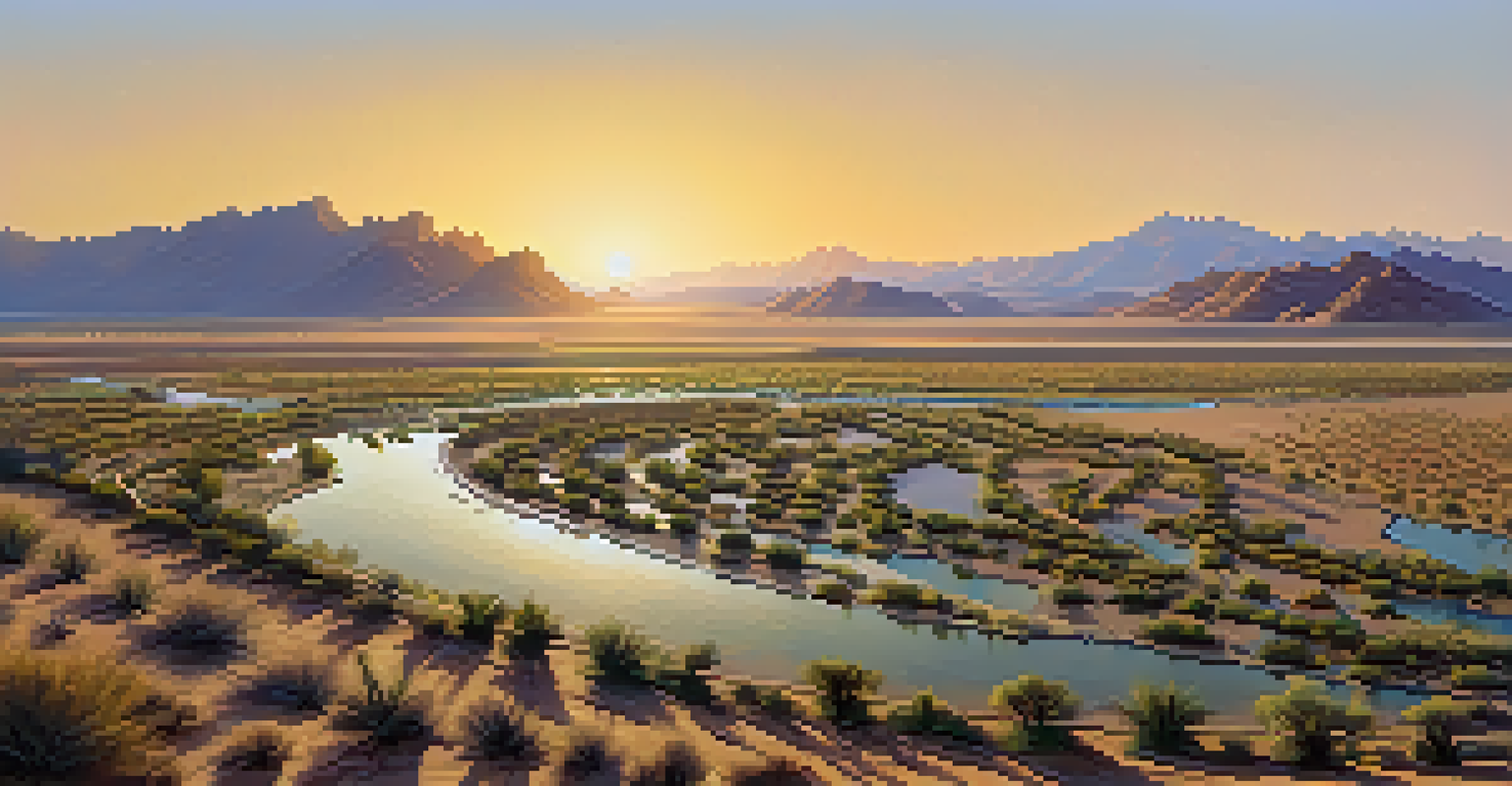The Archaeological Importance of Arizona's Artifacts

Introduction to Arizona's Rich Archaeological Heritage
Arizona is a treasure trove of archaeological wonders that tell the stories of ancient civilizations. From the Hohokam to the Ancestral Puebloans, each group left behind artifacts that provide insight into their lives and cultures. These remnants are not just relics; they are keys to understanding the past and how it shapes our present.
The past is never dead. It's not even past.
The landscape of Arizona, with its diverse ecosystems and geological features, has fostered a variety of human activities over thousands of years. The artifacts found here range from pottery and tools to intricate petroglyphs, each revealing unique aspects of the people who once inhabited this region. Such discoveries underscore the importance of protecting these sites for future generations.
As we delve into the archaeological significance of these artifacts, we begin to appreciate their role in connecting us to our ancestors. They serve as a bridge between past and present, offering a fascinating glimpse into the social, economic, and spiritual lives of the people who thrived in Arizona.
Key Artifacts and Their Cultural Significance
Among the most notable artifacts found in Arizona are the beautiful pottery pieces created by the Hopi and Zuni tribes. These vessels not only showcase artistic skill but also carry deep cultural meanings and stories. Each design element reflects the tribe's history and beliefs, making the pottery a vital aspect of their identity.

Another significant artifact category is the stone tools used by early inhabitants, which provide insight into their daily lives and survival strategies. From arrowheads to grinding stones, these tools reveal how ancient peoples adapted to their environment, hunted, and gathered food. The craftsmanship involved also speaks to their ingenuity and resourcefulness.
Arizona's Archaeological Treasures
Arizona is rich in archaeological artifacts that reveal the lives and cultures of ancient civilizations.
Petroglyphs, or rock carvings, found throughout the state are another fascinating aspect of Arizona's archaeological record. These images often depict animals, human figures, and abstract shapes, suggesting a rich tradition of storytelling and communication among ancient peoples. They invite us to ponder the meanings behind these symbols and their importance in the cultures that created them.
The Hohokam Culture and Their Innovations
The Hohokam people, who thrived in the Sonoran Desert, are known for their remarkable irrigation systems, which allowed them to farm in a challenging environment. They built an extensive network of canals that facilitated the growth of crops like corn, beans, and squash. This innovative approach to agriculture not only sustained their communities but also reflects their deep understanding of the landscape.
History is not a burden on the memory but an illumination of the soul.
Artifacts from the Hohokam include intricate pottery, jewelry, and tools, which highlight their skilled craftsmanship. Many of these items were traded with neighboring cultures, indicating a complex economy and social structure. The Hohokam's ability to adapt to their environment and engage in trade underscores their significance in Arizona's archaeological narrative.
Sadly, the Hohokam civilization declined around the 15th century, leaving behind a rich legacy of artifacts that continue to intrigue researchers today. By studying these remnants, we gain insights into the factors that contributed to their rise and fall, enriching our understanding of human resilience and adaptation.
Ancestral Puebloans: Masters of the Southwest
The Ancestral Puebloans, also known as the Anasazi, were another influential culture in Arizona's history. Renowned for their impressive cliff dwellings and pueblos, they exemplified architectural ingenuity and community organization. The remnants of their structures tell stories of collaboration, resource management, and adaptation to the arid environment.
Artifacts associated with the Ancestral Puebloans include beautifully crafted pottery and intricate baskets that showcase their artistic talents and daily living practices. These items often feature intricate designs that carry cultural significance, providing insights into their beliefs and social customs. Studying these artifacts helps us appreciate the rich tapestry of life in ancient Arizona.
Significance of Key Artifacts
Artifacts like pottery, stone tools, and petroglyphs provide insights into the daily lives, beliefs, and social structures of past cultures.
The decline of the Ancestral Puebloans is still a topic of research, with theories ranging from climate change to resource depletion. Their artifacts, however, remain as a testament to their remarkable achievements and enduring legacy in the region. Through continued archaeological efforts, we hope to uncover more about their fascinating culture and its impact on subsequent generations.
The Role of Arizona's Museums and Research Institutions
Arizona is home to several museums and research institutions dedicated to preserving and showcasing the state's archaeological heritage. These institutions play a vital role in educating the public about the importance of artifacts and the stories they tell. Exhibits often feature artifacts from various cultures, providing a comprehensive overview of Arizona's rich history.
Research institutions also engage in archaeological excavations and studies, contributing to our understanding of human history in the region. By collaborating with local tribes and communities, these organizations ensure that the cultural significance of artifacts is respected and preserved. This collaboration enhances the educational experience for visitors while honoring the traditions of Indigenous peoples.
In addition to traditional exhibits, many museums offer interactive experiences that engage visitors of all ages. Through hands-on activities, workshops, and guided tours, these institutions foster a deeper appreciation for Arizona's archaeological treasures. They encourage us to see artifacts not merely as objects but as vital pieces of our shared human experience.
Challenges in Preserving Archaeological Sites
Despite the importance of Arizona's archaeological artifacts, many sites face significant threats from urban development, climate change, and looting. As cities expand, ancient sites are often at risk of being destroyed or altered, leading to the loss of invaluable historical information. This reality underscores the need for increased awareness and proactive measures to protect these treasures.
Climate change also poses a threat to archaeological sites, as changing weather patterns can erode landscapes and expose artifacts to the elements. Preservation efforts must adapt to these challenges, employing innovative techniques to safeguard these important remnants of our past. By investing in conservation, we can ensure that future generations have the opportunity to learn from these artifacts.
Challenges in Site Preservation
Urban development and climate change pose significant threats to Arizona's archaeological sites, highlighting the need for proactive preservation efforts.
Communities, researchers, and policymakers must work together to create effective strategies for protecting archaeological sites. Public awareness campaigns and educational initiatives can foster a greater appreciation for these treasures, encouraging responsible tourism and advocacy for preservation efforts. Together, we can help safeguard Arizona's archaeological heritage for years to come.
The Future of Archaeological Research in Arizona
The future of archaeological research in Arizona looks promising, with advancements in technology opening new avenues for discovery. Techniques such as ground-penetrating radar and aerial surveys allow researchers to explore sites without disturbing the ground. These methods enhance our ability to locate and analyze artifacts, providing a clearer picture of ancient cultures.
Additionally, interdisciplinary collaboration between archaeologists, historians, and Indigenous communities is becoming increasingly common. This approach enriches our understanding of the past and ensures that the voices of those connected to the land are heard. By integrating traditional knowledge with modern research techniques, we can foster a more holistic view of Arizona's archaeological narrative.

As we move forward, the importance of education and public engagement cannot be overstated. Encouraging community involvement in archaeological projects helps raise awareness and appreciation for these artifacts. By fostering curiosity and respect for our shared history, we can inspire future generations to continue exploring the wonders of Arizona's archaeological heritage.